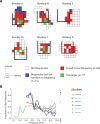Effects of Electrical Stimulation in the Inferior Colliculus on Frequency Discrimination by Rhesus Monkeys and Implications for the Auditory Midbrain Implant
- PMID: 27147659
- PMCID: PMC4854969
- DOI: 10.1523/JNEUROSCI.3540-15.2016
Effects of Electrical Stimulation in the Inferior Colliculus on Frequency Discrimination by Rhesus Monkeys and Implications for the Auditory Midbrain Implant
Abstract
Understanding the relationship between the auditory selectivity of neurons and their contribution to perception is critical to the design of effective auditory brain prosthetics. These prosthetics seek to mimic natural activity patterns to achieve desired perceptual outcomes. We measured the contribution of inferior colliculus (IC) sites to perception using combined recording and electrical stimulation. Monkeys performed a frequency-based discrimination task, reporting whether a probe sound was higher or lower in frequency than a reference sound. Stimulation pulses were paired with the probe sound on 50% of trials (0.5-80 μA, 100-300 Hz, n = 172 IC locations in 3 rhesus monkeys). Electrical stimulation tended to bias the animals' judgments in a fashion that was coarsely but significantly correlated with the best frequency of the stimulation site compared with the reference frequency used in the task. Although there was considerable variability in the effects of stimulation (including impairments in performance and shifts in performance away from the direction predicted based on the site's response properties), the results indicate that stimulation of the IC can evoke percepts correlated with the frequency-tuning properties of the IC. Consistent with the implications of recent human studies, the main avenue for improvement for the auditory midbrain implant suggested by our findings is to increase the number and spatial extent of electrodes, to increase the size of the region that can be electrically activated, and to provide a greater range of evoked percepts.
Significance statement: Patients with hearing loss stemming from causes that interrupt the auditory pathway after the cochlea need a brain prosthetic to restore hearing. Recently, prosthetic stimulation in the human inferior colliculus (IC) was evaluated in a clinical trial. Thus far, speech understanding was limited for the subjects and this limitation is thought to be partly due to challenges in harnessing the sound frequency representation in the IC. Here, we tested the effects of IC stimulation in monkeys trained to report the sound frequencies they heard. Our results indicate that the IC can be used to introduce a range of frequency percepts and suggest that placement of a greater number of electrode contacts may improve the effectiveness of such implants.
Keywords: auditory; auditory midbrain implant; electrical stimulation; inferior colliculus; prosthesis.
Copyright © 2016 the authors 0270-6474/16/365071-13$15.00/0.
Figures









References
-
- Aitkin LM, Moore DR. Inferior colliculus. II. Development of tuning characteristics and tonotopic organization in central nucleus of the neonatal cat. J Neurophysiol. 1975;38:1208–1216. - PubMed
MeSH terms
Grants and funding
LinkOut - more resources
Full Text Sources
Other Literature Sources
Medical
